
The LNER Class A4 is a class of streamlined 4-6-2 steam locomotive designed by Nigel Gresley for the London and North Eastern Railway in 1935. Their streamlined design gave them high-speed capability as well as making them instantly recognisable, and one of the class, 4468 Mallard, holds the record as the world's fastest steam locomotive. Thirty-five of the class were built to haul express passenger trains on the East Coast Main Line route from London Kings Cross via York to Newcastle, and later via Newcastle to Edinburgh, Scotland. They remained in service on the East Coast Main Line until the early 1960s when they were replaced by Deltic diesel locomotives; they themselves proving to be worthy successors to the A4s. Several A4s saw out their remaining days until 1966 in Scotland, particularly on the Aberdeen – Glasgow express trains, for which they were used to improve the timing from 3.5 to 3 hours.

The London and North Eastern Railway (LNER) was the second largest of the "Big Four" railway companies created by the Railways Act 1921 in Britain. It operated from 1 January 1923 until nationalisation on 1 January 1948. At that time, it was divided into the new British Railways' Eastern Region, North Eastern Region, and partially the Scottish Region.

LNER Class A4 4468 Mallard is a 4-6-2 ("Pacific") steam locomotive built in 1938 for operation on the London and North Eastern Railway (LNER) at Doncaster Works to a design of Nigel Gresley. Its streamlined, wind tunnel tested design allowed it to haul long distance express passenger services at high speeds. On 3 July 1938, Mallard broke the world speed record for steam locomotives at 126 mph (203 km/h), which still stands today.
The London and North Eastern Railway (LNER) produced several classes of locomotive, mostly to the designs of Nigel Gresley, characterised by a three-cylinder layout with a parallel boiler and round-topped firebox. It produced the most famous locomotive of its day, 4468 'Mallard', the holder of the world steam locomotive speed record. It also built the world-famous 4472 'Flying Scotsman'. However, its locomotive inheritance was much greater than just the 'A4 Class', it also produced highly successful mixed-traffic and freight designs.

A dynamometer car is a railroad maintenance of way car used for measuring various aspects of a locomotive's performance. Measurements include tractive effort, power, top speed, etc.
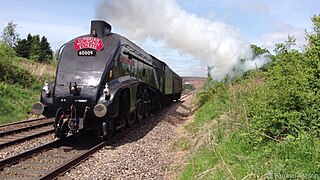
60009 Union of South Africa is a LNER Class A4 steam locomotive built at Doncaster Works on 16 April 1937. It is one of six surviving A4s. Its mainline certification expired in April 2020. As the locomotive is subject to a boiler inspection, it was moved to the East Lancashire Railway as the original plan was to keep it running there until the end of boiler certificate and then send it somewhere else for static display, but a cracked boiler tube forced it into retirement prematurely. It was briefly renamed Osprey during part of the 1980s and 1990s due to political opposition against apartheid in South Africa at the time.

The London and North Eastern Railway (LNER) Class V2 2-6-2 steam locomotives were designed by Sir Nigel Gresley for express mixed traffic work, and built at the LNER shops at Doncaster and Darlington between 1936 and 1944. The best known is the first of the class, 4771 Green Arrow, which is the sole survivor of the class.

60008 Dwight D Eisenhower is an LNER Class A4 steam locomotive named after Dwight D. Eisenhower, the United States General of the Army.

4464Bittern is a London and North Eastern Railway (LNER) Class A4 steam locomotive. Built for the LNER and completed on 18 December 1937 at Doncaster Works as works number 1866, it received number 4464. After that it was renumbered 19 on 16 August 1946 under the LNER 1946 renumbering scheme, and finally 60019 by British Railways on 10 October 1948, after nationalisation. Of the 35 strong class, it is one of six to survive into preservation but it is one of only two currently scheduled to be certified for mainline use.

LNER Class A4 4498 Sir Nigel Gresley is a preserved British steam locomotive built by Doncaster Works for the London & North Eastern Railway in 1937.

4489 Dominion of Canada is an LNER Class A4 steam locomotive. It is a 4-6-2 locomotive built to the same design by Sir Nigel Gresley as the more famous Mallard. There were 35 A4 locomotives built in total. Originally numbered 4489, it was renumbered 10 on 10 May 1946, under the LNER 1946 renumbering scheme of Edward Thompson and, after nationalisation in 1948, British Railways added 60000 to its number so it became 60010 on 27 October 1948. It was renumbered back to 4489 following a cosmetic restoration at the National Railway Museum in York during late 2012 and early 2013.
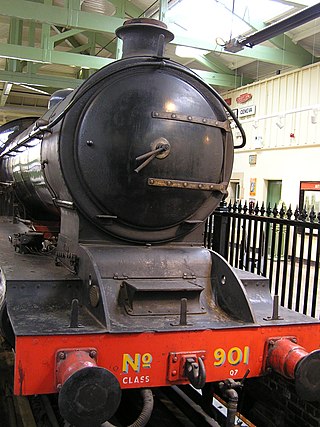
North Eastern Railway Class T3, classified Q7 by the LNER is a class of 0-8-0 steam locomotive designed for heavy freight. Five were built by the NER in 1919 and a further 10 by the London and North Eastern Railway (LNER) in 1924.
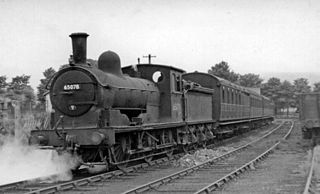
The North Eastern Railway (NER) Class C1, was a class of 0-6-0 freight locomotives designed by T.W. Worsdell. They were used throughout the NER system, although particularly in Teesside between 1886 and 1962.

The North Eastern Railway Class S3, classified B16 by the LNER, was a class of 4-6-0 steam locomotive designed for mixed traffic work. It was designed by Vincent Raven and introduced in 1920. The earlier members of this class were fitted with Westinghouse Brakes - all of this equipment was removed during the 1930s.

The NER Class ES1 was a class of two steeplecab electric locomotives commissioned by the North Eastern Railway in 1902.

The North Eastern Railway (NER) Class H, classified as Class Y7 by the London and North Eastern Railway (LNER) is a class of 0-4-0T steam locomotives designed for shunting.
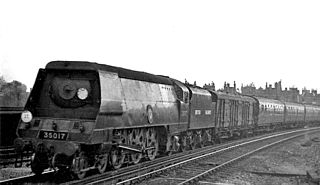
The 1948 Locomotive Exchange Trials were organised by the newly nationalised British Railways (BR). Locomotives from the former "Big Four" constituent companies were transferred to and worked on other regions. Officially, these comparisons were to identify the best qualities of the four different schools of thought of locomotive design so that they could be used in the planned BR standard designs. However, the testing had little scientific rigour, and political influence meant that LMS practice was largely followed by the new standard designs regardless. However, the trials were useful publicity for BR to show the unity of the new British Railways. To record the locomotive performances, one of three dynamometer cars were included in the train directly behind the locomotive.
The London and North Eastern Railway (LNER) inherited several styles of coaching stock from its constituents. Sir Nigel Gresley continued the styles that he had established pre-grouping at the Great Northern Railway (GNR) and for the East Coast Joint Stock.
The London and North Eastern Railway (LNER) operated various classes steam locomotives with a 4-6-2 wheel arrangement. The LNER operated more pacifics than any other of the Big Four British railway companies, and they were mostly used for express passenger work along the East Coast Main Line, though later in their lives many were displaced to other lines.
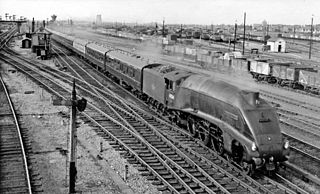
LNER Class A4 60034 Lord Faringdon was one of 35 Doncaster built Class A4 Gresley Pacific steam locomotives.


















